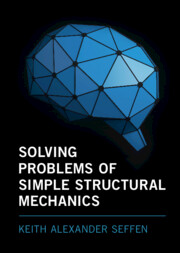Refine search
Actions for selected content:
8126 results in Fluid dynamics and solid mechanics
17 - The Third Dimension
- from Part V - Design Choices
-
- Book:
- Solving Problems of Simple Structural Mechanics
- Published online:
- 06 January 2022
- Print publication:
- 20 January 2022, pp 140-146
-
- Chapter
- Export citation
11 - Deflection Coefficients
- from Part IV - Beams and Frames: Analysis
-
- Book:
- Solving Problems of Simple Structural Mechanics
- Published online:
- 06 January 2022
- Print publication:
- 20 January 2022, pp 88-94
-
- Chapter
- Export citation
Author’s Note
-
- Book:
- Solving Problems of Simple Structural Mechanics
- Published online:
- 06 January 2022
- Print publication:
- 20 January 2022, pp xiii-xviii
-
- Chapter
- Export citation
4 - Statical (In)determinacy in Trusses
- from Part II - Truss Frameworks
-
- Book:
- Solving Problems of Simple Structural Mechanics
- Published online:
- 06 January 2022
- Print publication:
- 20 January 2022, pp 31-36
-
- Chapter
- Export citation
Part V - Design Choices
-
- Book:
- Solving Problems of Simple Structural Mechanics
- Published online:
- 06 January 2022
- Print publication:
- 20 January 2022, pp 103-104
-
- Chapter
- Export citation
15 - Cross-Sectional Strength
- from Part V - Design Choices
-
- Book:
- Solving Problems of Simple Structural Mechanics
- Published online:
- 06 January 2022
- Print publication:
- 20 January 2022, pp 123-132
-
- Chapter
- Export citation
Preface
-
- Book:
- Solving Problems of Simple Structural Mechanics
- Published online:
- 06 January 2022
- Print publication:
- 20 January 2022, pp vii-xi
-
- Chapter
- Export citation
21 - Hooke and Heat
- from Part VI - Deliberately Deformed
-
- Book:
- Solving Problems of Simple Structural Mechanics
- Published online:
- 06 January 2022
- Print publication:
- 20 January 2022, pp 177-182
-
- Chapter
- Export citation
12 - Moment Distribution: At the Junction
- from Part IV - Beams and Frames: Analysis
-
- Book:
- Solving Problems of Simple Structural Mechanics
- Published online:
- 06 January 2022
- Print publication:
- 20 January 2022, pp 95-102
-
- Chapter
- Export citation
10 - Standard Beam Deflections
- from Part IV - Beams and Frames: Analysis
-
- Book:
- Solving Problems of Simple Structural Mechanics
- Published online:
- 06 January 2022
- Print publication:
- 20 January 2022, pp 83-87
-
- Chapter
- Export citation
Contents
-
- Book:
- Solving Problems of Simple Structural Mechanics
- Published online:
- 06 January 2022
- Print publication:
- 20 January 2022, pp v-vi
-
- Chapter
- Export citation
7 - Drawing Well: Bending Moment (and Shear Force) Diagrams
- from Part III - Beams and Frames: Character
-
- Book:
- Solving Problems of Simple Structural Mechanics
- Published online:
- 06 January 2022
- Print publication:
- 20 January 2022, pp 55-64
-
- Chapter
- Export citation
9 - Sequence Spaces
- from Part III - Beams and Frames: Character
-
- Book:
- Solving Problems of Simple Structural Mechanics
- Published online:
- 06 January 2022
- Print publication:
- 20 January 2022, pp 72-80
-
- Chapter
- Export citation
Acknowledgements
-
- Book:
- Solving Problems of Simple Structural Mechanics
- Published online:
- 06 January 2022
- Print publication:
- 20 January 2022, pp xii-xii
-
- Chapter
- Export citation
3 - Simple Cables
- from Part I - Simple Structures
-
- Book:
- Solving Problems of Simple Structural Mechanics
- Published online:
- 06 January 2022
- Print publication:
- 20 January 2022, pp 22-28
-
- Chapter
- Export citation
16 - Back of the Envelope: Beam Design by Lower Bound
- from Part V - Design Choices
-
- Book:
- Solving Problems of Simple Structural Mechanics
- Published online:
- 06 January 2022
- Print publication:
- 20 January 2022, pp 133-139
-
- Chapter
- Export citation
Part I - Simple Structures
-
- Book:
- Solving Problems of Simple Structural Mechanics
- Published online:
- 06 January 2022
- Print publication:
- 20 January 2022, pp 1-2
-
- Chapter
- Export citation
2 - Equilibrium of Pseudo-Deformed Bodies
- from Part I - Simple Structures
-
- Book:
- Solving Problems of Simple Structural Mechanics
- Published online:
- 06 January 2022
- Print publication:
- 20 January 2022, pp 14-21
-
- Chapter
- Export citation

Solving Problems of Simple Structural Mechanics
-
- Published online:
- 06 January 2022
- Print publication:
- 20 January 2022
1 - Introduction
-
-
- Book:
- Advanced Turbulent Combustion Physics and Applications
- Published online:
- 09 December 2021
- Print publication:
- 06 January 2022, pp 1-24
-
- Chapter
- Export citation
